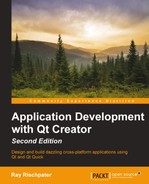To access the camera when it is supported by the hardware and Qt Multimedia, use the Camera type and its associated types to control the camera's capture behavior, exposure, flash, focus, and image processing settings. A simple use of the camera to show a viewfinder looks like the following code:
import QtQuick 2.3
import QtMultimedia 5.0
Item {
width: 640
height: 480
Camera {
id: camera
}
VideoOutput {
source: camera
anchors.fill: parent
}
}In short, the Camera type acts like a source for the video just as a MediaPlayer instance does.
The Camera type provides a few properties to control its behavior. They are:
imageCapture: This is an instance ofCameraCapture, which defines how the camera should capture an imagevideoRecording: This is an instance ofCameraRecorder, which defines how the camera should capture a videoexposure: This is an instance ofCameraExposure, which controls the various options for the exposure mode of the camerafocus: This is an instance ofCameraFocus, which controls the auto- and manual-focusing behaviorsflash: This is an instance ofCameraFlash, which controls the camera flashimageProcessing: This is an instance ofCameraImageProcessing, which controls the real-time image processing pipeline options such as white balance, saturation, and sharpening
The types associated with these fields can't be instantiated directly.
To have the camera take a picture, specify the imageCapture property and invoke its capture method, as follows:
import QtQuick 2.3
import QtMultimedia 5.0
Item {
width: 640
height: 360
Camera {
id: camera
imageCapture {
onImageCaptured: {
// Show the preview in an Image
photoPreview.source = preview
}
}
}
VideoOutput {
source: camera
focus : visible // to receive focus and capture key events when visible
width: 320
height: 180
anchors.top: parent.top
anchors.horizontalCenter: parent.horizontalCenter
MouseArea {
anchors.fill: parent;
onClicked: camera.imageCapture.capture();
}
}
Image {
id: photoPreview
width: 320
height: 180
anchors.bottom: parent.bottom
anchors.horizontalCenter: parent.horizontalCenter
}
}Here, the camera displays its viewfinder in the top VideoOutput item and has an Image item at the bottom to display the captured image. When you touch the viewfinder, the QML invokes the capture method of imageCapture, which is part of Camera, capturing the image and updating the bottom image.
The imageCapture property of the Camera item also has a capturedImagePath property, which is a string to the path where the last captured image is stored.
Recording works in a similar manner; you specify the attributes of the recording, such as the desired codec in the videoRecording property, and then invoke its record and stop methods to start and stop recording. The resulting video will be stored at the location indicated by the property's actualLocation field.
Note
For more information on the actual attributes available to applications using the Camera type, see the Qt Multimedia documentation for the Camera type at http://qt-project.org/doc/qt-5/cameraoverview.html.
